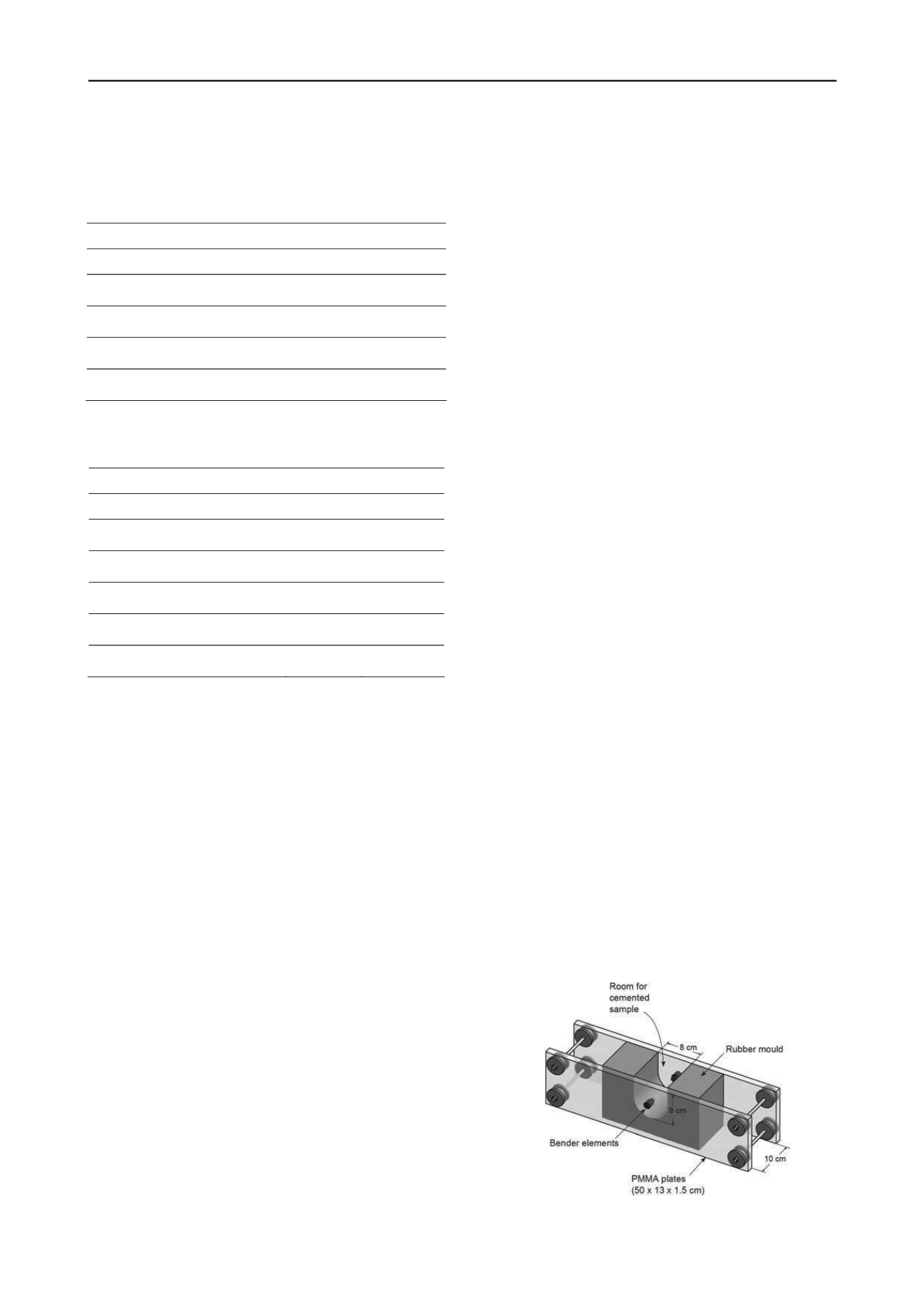
978
Proceedings of the 18
th
International Conference on Soil Mechanics and Geotechnical Engineering, Paris 2013
Some properties of the clay and the chemical composition
of the clay and cement used here are summarized in Table 1 and
Table 2, respectively.
Table 1. Physical properties of the bentonite clay
Parameter
Value
Liquid limit
541.9
Plastic limit
67.0
Plasticity index
474.9
Swell index (ml/2g)
34
Cation exchange capacity (meq/100g)
73
Table 2. Chemical composition of the blast furnace slag cement & clay
Main component
Cement
Bentonite
SiO
2
(%)
29.3
53.7
Al
2
O
3
(%)
8.8
23.4
Fe
2
O
3
(%)
1.2
5.9
MgO (%)
6.7
2.4
CaO (%)
47.1
1.9
Na
2
O (%)
0.2
2.2
The prepared samples consist of 80% water, 16% cement
and 4% bentonite (by weight). This composition is in agreement
with other studies in the literature (e.g. Ryan and Day 1986,
Jefferis 1992, Opdyke and Evans 1995). First, a slurry of
bentonite and water was mixed with a high-speed shear mixer
for 5 minutes. The slurry was poured in a closed container and
allowed to hydrate for about 24 hours. Subsequently, a slurry
cement and water (accounted for in the final composition) was
prepared to obtain a water cement ratio of about 0.5. Finally, the
cement slurry and the 24-hour hydrated bentonite slurry were
mixed in a dough mixer for about 10 minutes.
Then the fresh CB slurry was poured in stainless-steel
moulds to prepare cylindrical specimens. The moulds were
lightly vibrated to ensure that any trapped air bubbles were
removed. The bottom and top ends of the mould were sealed
with plastic foil to prevent moisture loss. Then, the samples
were allowed to cure for 7 days in a conditioned room at 18°C.
After that period, when the samples showed enough strength to
be handled, their ends were flattened with a spatula and they
were carefully extruded out of the moulds. Samples with a
diameter of 100 mm and a height of 60 mm were used for
hydraulic conductivity tests.
3 METHODS
The hydraulic conductivity and small-strain shear modulus of a
CB sample were studied in a flexible-wall hydraulic
conductivity cell provided with bender elements. In parallel, the
hardening of the CB mix in contact with water was monitored
through bender element testing in a bench top setup to provide a
reference of
G
0
increase under normal curing conditions.
3.1 Bench top bender element test
The small-strain shear modulus of the CB mix was evaluated
(starting from a fresh state) by bender element testing (Shirley
and Hampton 1978, Dyvik and Madshus 1985) in a bench top
setup (Fig. 1). The bender elements used here are of the type
T220-A4–203Y (Piezo Systems, Inc.). The effective bender
element length penetrating in the sample was about 4.5 mm.
The bench top bender element setup consists of two
translucent polymethyl methacrylate (PMMA) plates that hold a
U-shaped rubber mould with an open space for housing a
cemented sample. The bender element transmitter and receiver
are fixed to the PMMA plates, one in front of the other and
vertically aligned. All parts are held together by four sets of
screws and nuts resting on rubber disks to avoid wave
propagation through the apparatus itself. More details on this
setup are given by Verastegui-Flores et al. (2010).
Testing was started immediately after a fresh CB mix was
prepared. The mix was poured into the rubber mould and it was
allowed to cure in a conditioned room at constant temperature
(18°C). In order to avoid desiccation, the sample was kept all
the time under a thin layer of purified water. Bender element
measurements were performed on a regular basis from the first
day of curing up to 2 months approximately.
In bender element testing,
G
0
is determined out of the
propagation velocity (
V
s
) of shear waves generated and detected
by the transmitter and receiver bender elements installed on
opposite sides of a sample.
G
0
is estimated as:
G
0
=
V
s
2
(1)
where
is the density of the sample.
V
s
is evaluated as follows:
V
s
= L / t
s
(2)
where
L
is the tip-to-tip distance between the transmitter and
receiver bender elements, and
t
s
is the travel time of the shear
waves from the transmitter to the receiver.
t
s
is evaluated out of
the signal recordings. In this research,
t
s
was evaluated by
means of two methods. The first one consists of visually
identifying the first direct arrival from the output signal (e.g.
Dyvik and Madshus 1985, Jovičić et al. 1996; Viggiani and
Atkinson 1995). Clearly, the success of this method depends on
the quality of the recorded signal. The second method used here
was the cross-correlation method, first introduced by Viggiani
and Atkinson (1995). The cross-correlation analysis measures
the level of correspondence or interrelationship between two
signals of similar nature and it produces the time shift between
them, which is equivalent to the travel time of the shear wave.
Although some authors argue that the cross-correlation method
may not be suitable for bender element interpretation (e.g.
Arulnathan et al. 1998), it produced very consistent results.
Both methods produced a similar outcome.
Figure 1. Bench top bender element setup


